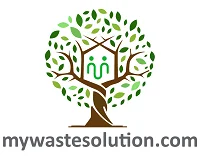1. Introduction
The ISO 14000 Elements play a crucial role for organizations striving for effective environmental management. The International Standards Organization (ISO), a non-governmental organization, focuses on enhancing the development and delivery of products and services with the goals of improving efficiency, ensuring safety, and fostering sustainability.
By concentrating on the ISO 14000 Elements, organizations can identify essential actions that mitigate harmful impacts and enhance ecological performance. Moreover, adhering to these standards enables us to comprehend their benefits for the ecosystem and improve overall organizational effectiveness.
In this article, we will explore the significance of the ISO 14000 environmental management system (EMS) and its crucial role in promoting sustainable practices across various industries and households.
1.1 Overview of ISO 14000 Elements:
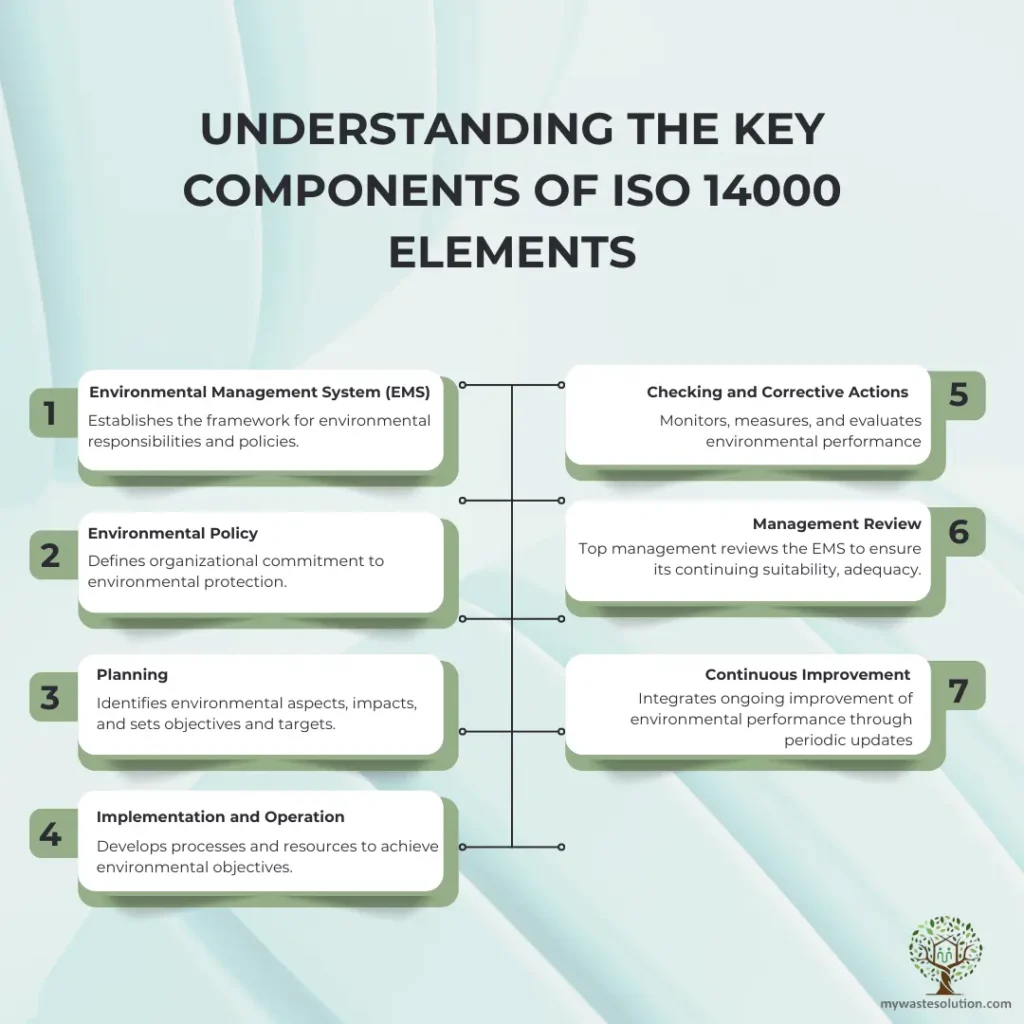
The International Organization for Standardization (ISO) introduced the ISO 14000 Elements in 1996 to assist companies in minimizing their ecological footprint. These guidelines, therefore, are designed to facilitate effective sustainable governance and evaluate corporate performance. Research indicates that adopting these protocols enhances both sustainability and business outcomes.
Although certification in the ISO 14000 System is optional, over 400,000 entities worldwide have obtained it, according to the latest Standards organization survey. These universally applicable guidelines, developed by a non-governmental entity with input from organizations like the U.S. Eco-friendly Protection Agency, emphasizes voluntary implementation.
Companies implementing the International Standards Organization (ISO) 14000 framework can earn certification to showcase their commitment to sustainable practices. Moreover, ISO 9000, introduced in 1987, focuses on quality assurance. In addition, ISO 14001 provides a structured management framework utilizing the Plan-Do-Check-Act model. Notably, the key elements of the Environmental Management System (EMS) include:
1. Environmental Policy
2. Planning
3. Implementation & Operations
4. Monitoring and Corrective Measures
5. Organizational Review
6. Continuous Improvement
Key standards in the ISO 14000 series include:
- ISO 14001: Ecological Management Systems
- ISO 14004: Guidelines for Environmental-friendly Best Practices
- ISO 14010 – ISO 14015: Auditing Procedures for Sustainability
- ISO 14020 – ISO 14024: Eco-friendly Labeling Protocols
- ISO 14031 – ISO 14032: Performance Evaluation for Sustainable development
- ISO 14040 – ISO 14043: Life Cycle Assessment Framework
- ISO 14050: Definitions and Terminology
Understanding these components of the ISO 14000 Elements provides valuable insights into their role in fostering Eco-consciousness and enhancing corporate accountability.
Explore Environmental Management System Solutions
Find top machinery, plants, tools, resources, companies, and consultancy for comprehensive ISO 14000 needs and solutions..
1.2 Core Principles of Environmental Management Systems:
The ISO 14000 Elements family provides essential management tools for organizations to effectively manage their eco-friendly aspects and evaluate their sustainable performance. Furthermore, in the global economy, businesses must address the triple bottom line—economic, social, and ecological factors—to gain benefits in financing, insurance, marketing, and regulatory matters. This framework allows firms to adopt a proactive approach to Environmental Administration, addressing impacts like energy consumption and resource utilization, even if they aren’t strictly regulated.
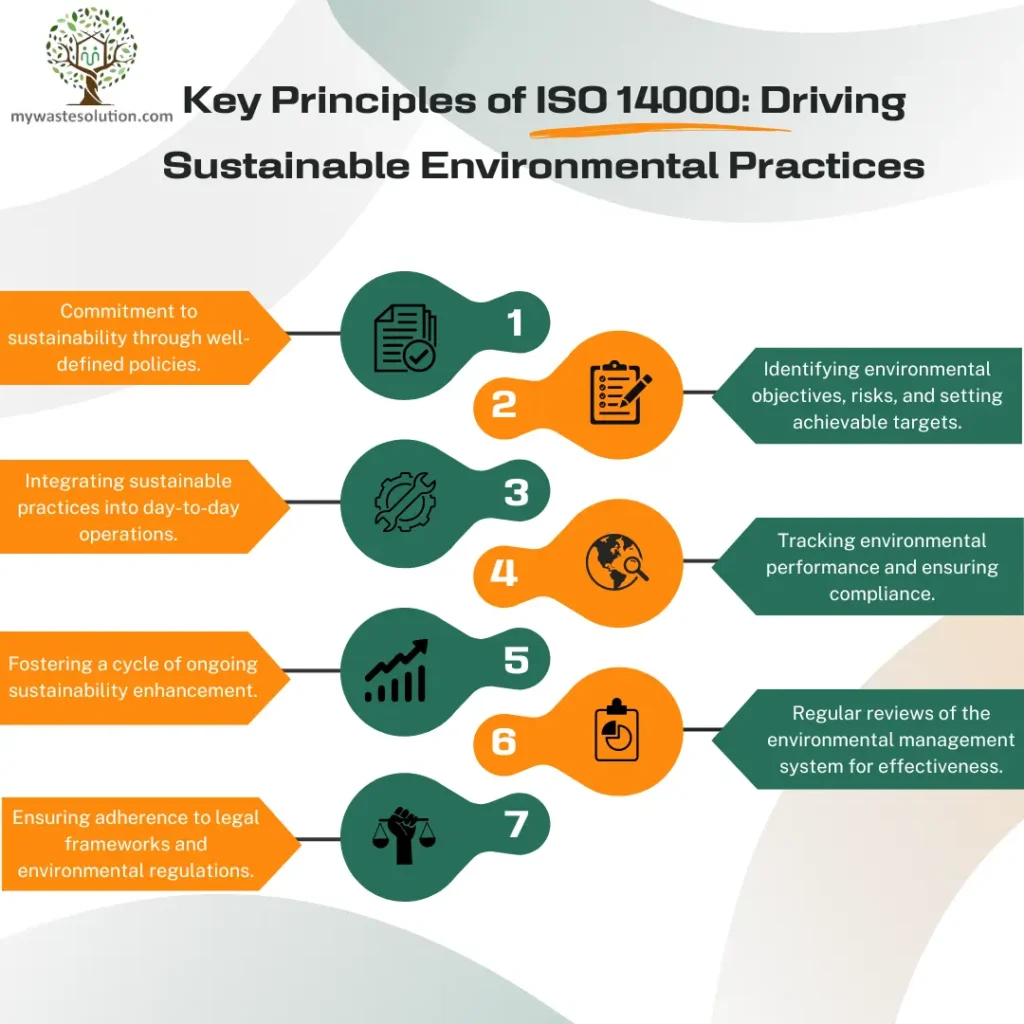
2. Importance of ISO 14000 in Environmental Management
Adopting the ISO 14000 Elements Environmental Management System (EMS) offers numerous advantages that significantly enhance environmental performance. Moreover, these standards improve internal management, boost stakeholder satisfaction, and help organizations avoid non-tariff trade barriers. In addition, this proactive approach provides a competitive edge, reduces regulatory inspections, and ultimately lowers operational costs. It also helps decrease non-compliance fines, improves access to capital, and lowers insurance premiums, boosting a company’s overall image.
Struggling with ISO 14000 needs? Connect with top consultants specializing in ISO 14000 solutions.
Connect NowKey benefits of implementing ISO 14000 include:
- Compliance with current and future statutory and regulatory requirements.
- Increased leadership involvement and employee engagement.
- Enhanced company reputation and stakeholder confidence.
- Alignment of Eco-friendly considerations with business goals.
- Competitive and financial advantages through improved efficiencies and cost reductions.
- Encouraging better Sustainable Performance from suppliers.
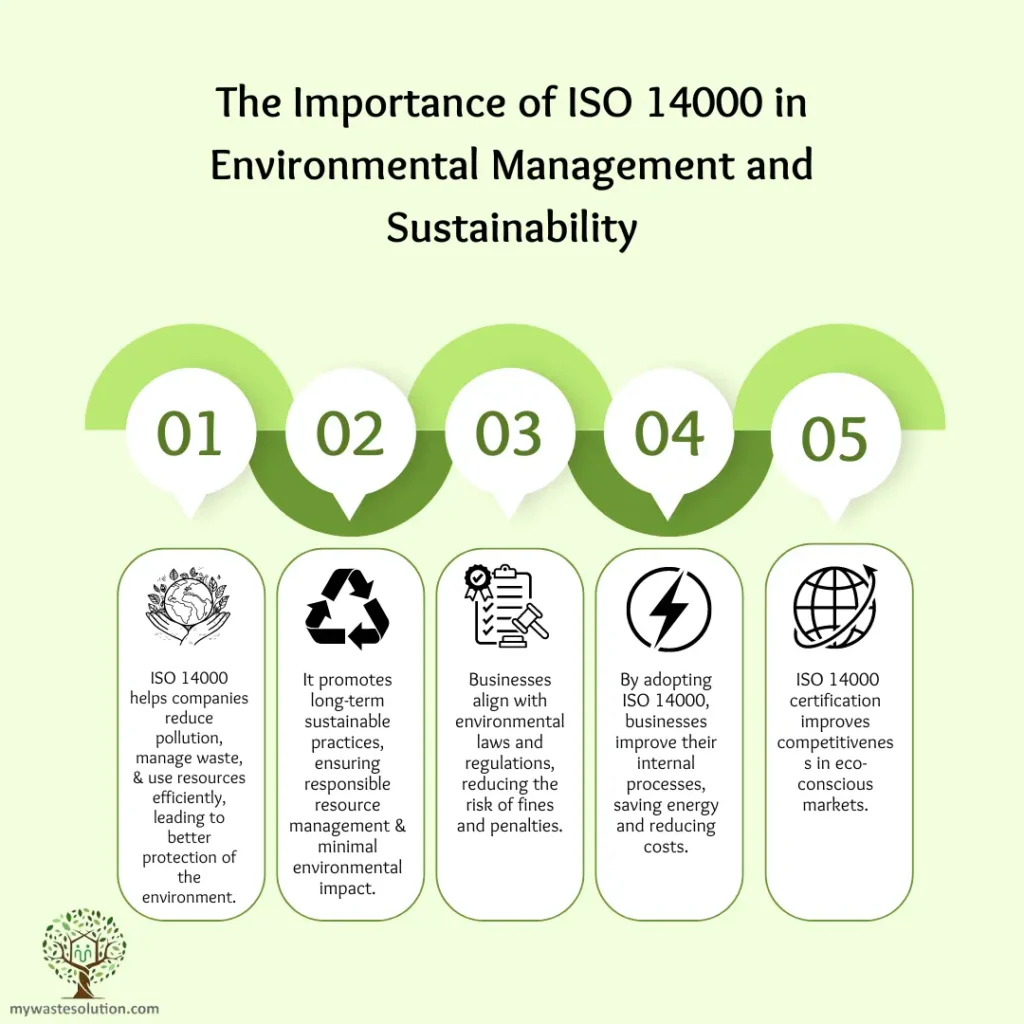
3. Key Requirements of ISO 14000 Elements
The ISO 14000 Elements framework is primarily driven by the Global Standards Organization, which provides comprehensive guidelines for implementing an Environmental Management System (EMS). Furthermore, the ISO 14001:2015 requirements are structured into ten sections, ensuring organizations can effectively meet environmental management goals. Clauses 1 to 3 define the standard, while Articles 4 to 10 outline the essential components for an effective Ecological Performance System:
- Scope
- Normative references
- Terms and definitions
- Context of organization
- Leadership and worker participation
- Planning
- Support
- Operation
- Performance evaluation
Following these provisions enables Companies to build a strong Sustainable Administration Strategy that improves both operational efficiency and sustainability.
Find and connect with leading companies specializing in ISO 14000 solutions.
Get Connected Today
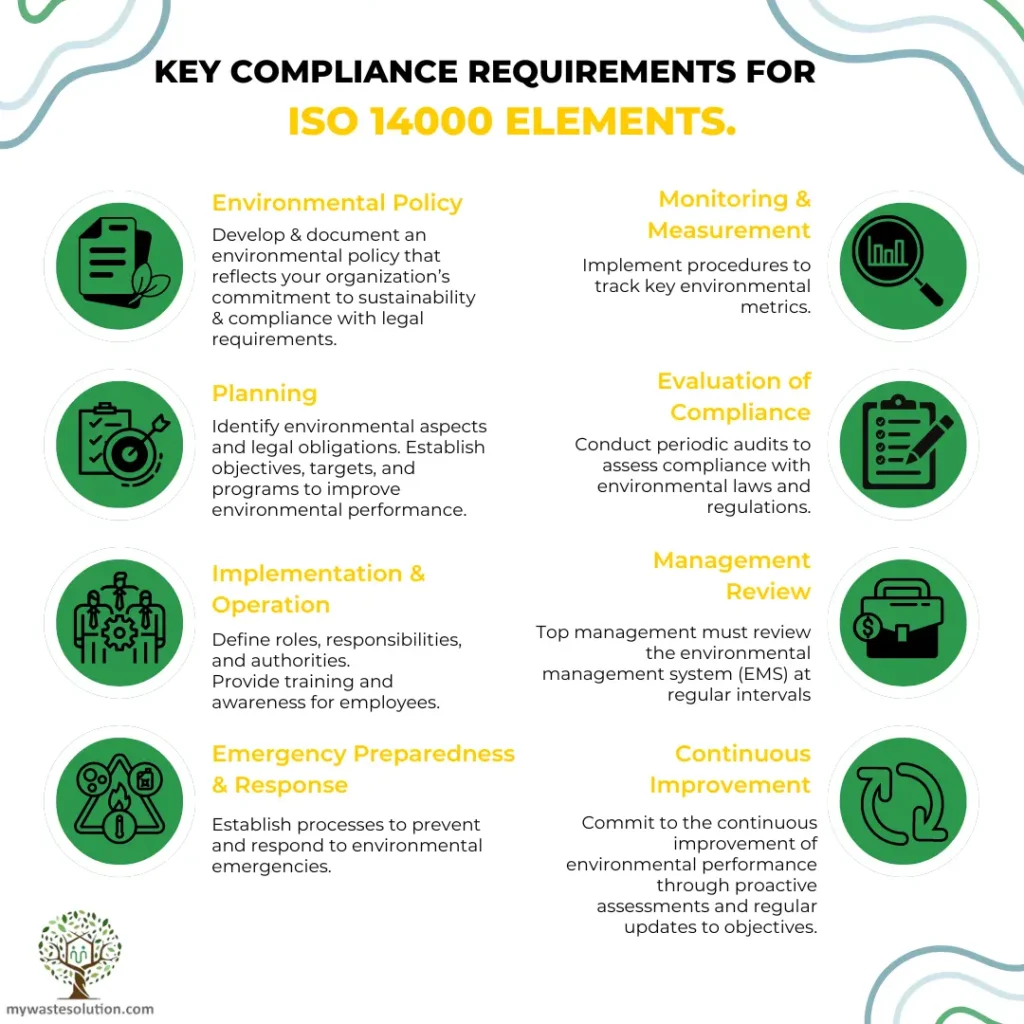
3.1 Scope and Application of ISO 14000 Elements:
This document helps organizations achieve the desired results of their Occupational Health and Safety (OHS) Management System, in line with their Safety compliance policy. Key outcomes include:
- Continual improvement of Employee risk management performance
- Compliance with legal requirements and other obligations
- Achieving specific Workplace Protection objectives
This document does not cover areas such as product protection, property damage, or environmental impacts unrelated to worker security. Organizations can use it to systematically improve their OHS administration system, but claims of conformity are valid only if all requirements are fully implemented without exception.
3.2 Normative References for ISO 14000:
Regarding the ISO 14000 Elements, it’s important to note that no outside references are included in the document. This ensures that these guidelines are complete and designed to function independently, eliminating the need for external guidance or additional sources.
3.3 Definitions and Terminology in ISO Standards:
The ISO 14000 Elements document provides a comprehensive overview of key terms and definitions. Understanding these terms is essential for organizations to successfully implement the standards. Moreover, it ensures smooth operation within their Environmental Management System (EMS) and full compliance with the outlined requirements.
3.4 Understanding Organizational Context in ISO 14000:
This section focuses on gaining a comprehensive understanding of the organization and its context. It involves identifying the needs and expectations of employees and other interested parties, as well as determining the scope of the Environmental Management System (EMS). By addressing these components, organizations can effectively align their practices with the ISO 14000 Elements standards.
3.5 Leadership and Employee Engagement in ISO Implementation:
In this section, we closely examine the important role of leadership and commitment in effectively implementing ISO 14000 Elements. To begin with, it addresses the establishment of a strong Environmental Management System (EMS) policy, and furthermore, it clearly defines organizational roles and responsibilities. Additionally, it emphasizes the importance of consultation and active participation among employees. By doing so, engaging workers in these processes not only fosters a collaborative environment, but also significantly strengthens the overall effectiveness of the eco-management strategy.
3.6 Strategic Planning for ISO 14000 Compliance:
This section clearly outlines the essential actions for addressing both threats and opportunities associated with ISO 14000 compliance. First, it involves hazard identification, followed by the assessment of risks and possibilities. Additionally, it focuses on setting Environmental Management System (EMS) objectives and establishing project oversight strategies to ensure these goals are met. Moreover, effective planning is crucial for organizations to not only enhance their sustainable performance but also ensure proper alignment with ISO 14000 Elements standards.
3.7 Necessary Support for ISO 14000 Implementation:
This important section details the key resource requirements necessary for the effective implementation of the Environmental Management System (EMS). It covers competency assessments, training programs, and strategies for increasing employee awareness. Additionally, it highlights the importance of controlling documented information related to the EMS and managing both internal and external communications that are relevant to your Ecological Oversight Framework. Ensuring adequate support in these areas is vital for the successful implementation of ISO 14000 Elements. (link for details)
3.8 Operational Frameworks Under ISO Standards:
Though this section is concise, it plays a crucial role in establishing the requirements for planning the control of your operations. This section explains how organizations should be prepared to handle emergency sustainable situations. By establishing strong operational procedures, businesses can ensure compliance with ISO 14000 Elements while effectively minimizing environmental risks. (link for details.)
3.9 Methods for Performance Evaluation in ISO 14000:
This section highlights the essential processes for monitoring, measuring, and evaluating your Environmental Management System (EMS). It includes ensuring compliance with legal requirements and conducting regular internal Evaluations for assessment Framework performance. These audits identify issues and drive necessary corrections. Additionally, Oversight must review the Sustainability Management to ensure its effectiveness and continuous improvement. This review also ensures the allocation of adequate resources, enabling the EMS to meet the ISO 14000 Elements standards and function optimally. (link for details.)
3.10 Continuous Improvement Strategies for ISO 14000:
This section outlines the key guidelines for addressing nonconformities within your Environmental Management System (EMS) processes. It details the corrective actions needed to resolve these issues and emphasizes the significance of continual enhancement activities. This proactive strategy enables organizations to identify potential problems before they occur, enhancing efforts to improve Procedures related to sustainable impact. By following these improvement requirements, businesses can effectively reduce their ecological footprint and align with the standards established by ISO 14000 Elements. (link for details.)
4. Comparing ISO 14000 and ISO 9000: Key Differences

| Sr No : | ISO 14000 | ISO 9000 |
| 1) | This approach specifically emphasizes the ecological aspects of quality oversight. | Offers a comprehensive Structure for implementing quality certainty across an organization. |
| 2) | It meets the needs of customers and other stakeholders, incorporating environmental factors into decision making. | Major system requirements are primarily driven by Consumer needs. |
| 3) | The framework includes strategies for assessing environmental consequences and their associated processes. | Emphasizes the evaluation of suppliers and the review of client contracts. |
| 4) | Environmental management frameworks can be intricate and differ based on the specific context. | The objectives of a quality assurance framework are typically more straightforward and well-defined. |
5. Overview of the ISO 14000 Family of Standards

The ISO 14000 relies on following family:-
| ISO Guide 64:1997 | Guide for the inclusion of environmental aspects in product standards. |
| ISO 14001:2004 , 14004:2004 | Environmental management systems |
| ISO 14015:2001 | Environmental management-Environmental assessment of sites and organizations.(EASO) |
| ISO 14020:2000, 14021:1999, 14024:1999, 14025:2006 | Environmental labels and declarations |
| ISO 14031:1999, ISO/TR 14032:1999 | Environmental management -Environment performance evaluation |
| ISO 14040:2006,14044:2006,ISO/TR 14048:2002, 14049:2000 | Environment management – Life cycle assessment. |
| ISO 14050:2002 | Environmental management – vocabulary |
| ISO/TR 14062:2002 | Environmental management- Integrating environmental aspects into product design and development. |
| ISO 14063:2006 | Environmental management-environmental communication-guidelines and examples |
| ISO 14064-1:2006 | Greenhouse gasses-Part 1:Specification with guidance at the organization level for the quantification and reporting of greenhouse gasses emissions and removals |
| ISO 14064-2:2006 | Greenhouse gasses-Part 2: Specification with guidance at the level for quantification, monitoring and reporting of greenhouse emission reductions or removal enhancements |
| ISO 14065-3:2006 | Greenhouse gasses-part 3: Specification with Guidance for the Validation and Verification of Greenhouse Gas Assertions |
| ISO 14065:2007 | Greenhouse gasses- requirements for greenhouse gas validation and verification bodies for use in accreditation or other forms of recognition. |
6. Certification Process for ISO 14000 Elements
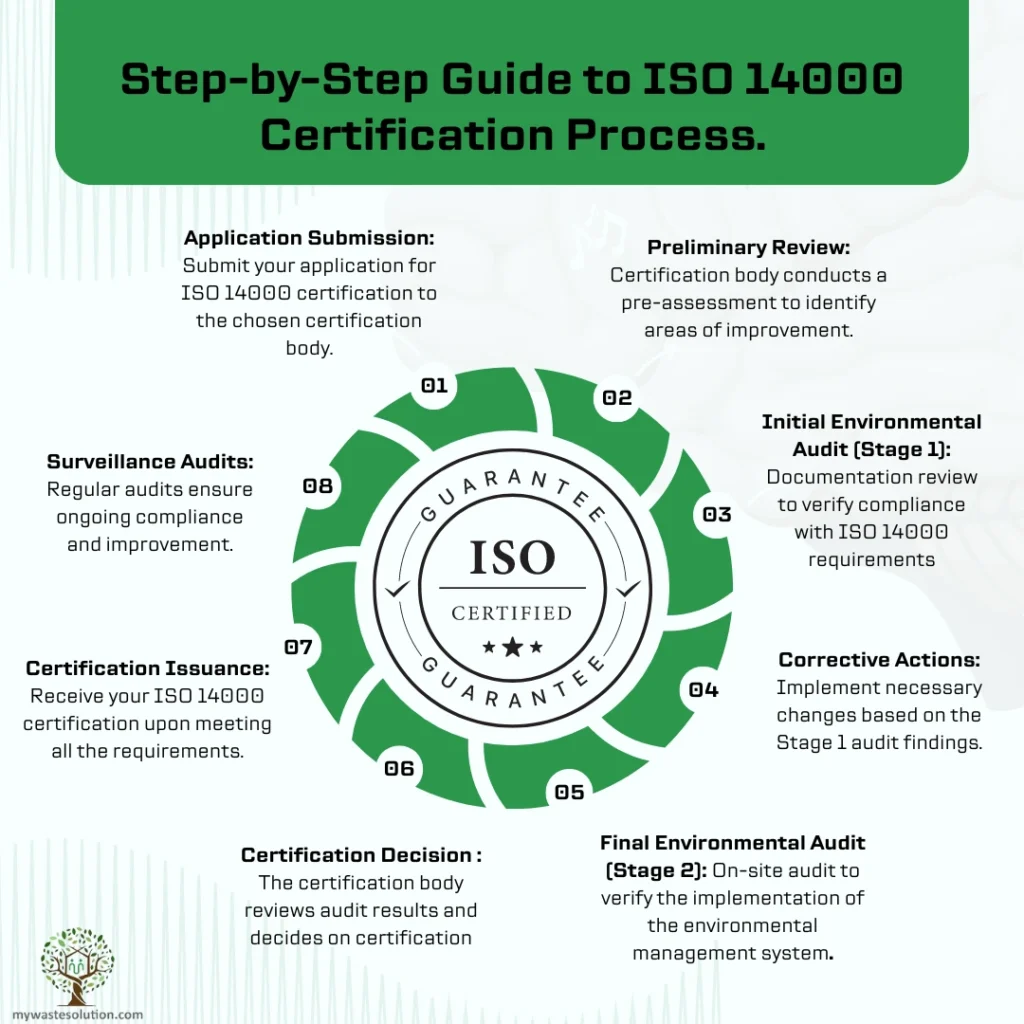
Let’s walk through the ISO 14000 certification process! Based on the PDCA (Plan-Do-Check-Act) cycle for continuous improvement, once you feel your business is prepared, you can seek qualification from a third-party organization.
ISO 14000 guidelines in the certification process:
Below are the key steps involved in the certification procedure –
| Steps | Description |
| Step 1 – Conduct an initial assessment | Prior to seeking an external review, conduct a thorough self-evaluation to gauge your current compliance with ISO 14000 Elements. This internal assessment allows your organization to assess its status in relation to the relevant standards. Once you feel adequately prepared, request an initial evaluation from an independent certification evaluator. The inspector will analyze your existing Environmental Management Framework (EMF), pinpoint areas needing enhancement, and improve your readiness for ISO 14000 accreditation. |
| Step 2 – Document operations | To align with ISO 14000 Elements, organizations must maintain a comprehensive audit trail. This includes clearly documenting Sustainable policies, objectives, targets, and identified environmental impacts and aspects. All improvement initiatives, along with Key Performance Indicators (KPIs) and benchmark data, should be recorded to track progress. Transparent documentation is essential for demonstrating compliance and readiness for ISO 14000 certification. |
| Step 3 – Obtain third-party certification verification | Certification auditors from an independent third-party agency will visit your Entity to confirm that the information reported aligns with actual practices. These evaluators, who specialize in ISO 14000 certification, operate independently from the ISO organization. The evaluation process involves onsite audits and may include interviews with staff to ensure compliance with the ISO 14000 Elements. |
| Step 4 – Non-conformity resolution | During the certification process, any identified non-conformities must be addressed. Minor non-conformities should be resolved within 60 days from the audit date to maintain compliance with ISO 14000 Elements. Promptly addressing these issues ensures your organization remains on track for ISO 14000 certification. |
| Step 5 – Attaining and retaining certification | After implementing necessary corrective actions and providing proper documentation, the certifying body will assess whether your organization meets ISO 14000 standards. If compliant, your business will receive certification, which is valid for three years. However, the certified site will undergo bi-annual and annual external audits to ensure ongoing compliance with ISO 14000 Elements throughout the certification period. |
7. Advantages and Disadvantages of ISO 14000 Elements
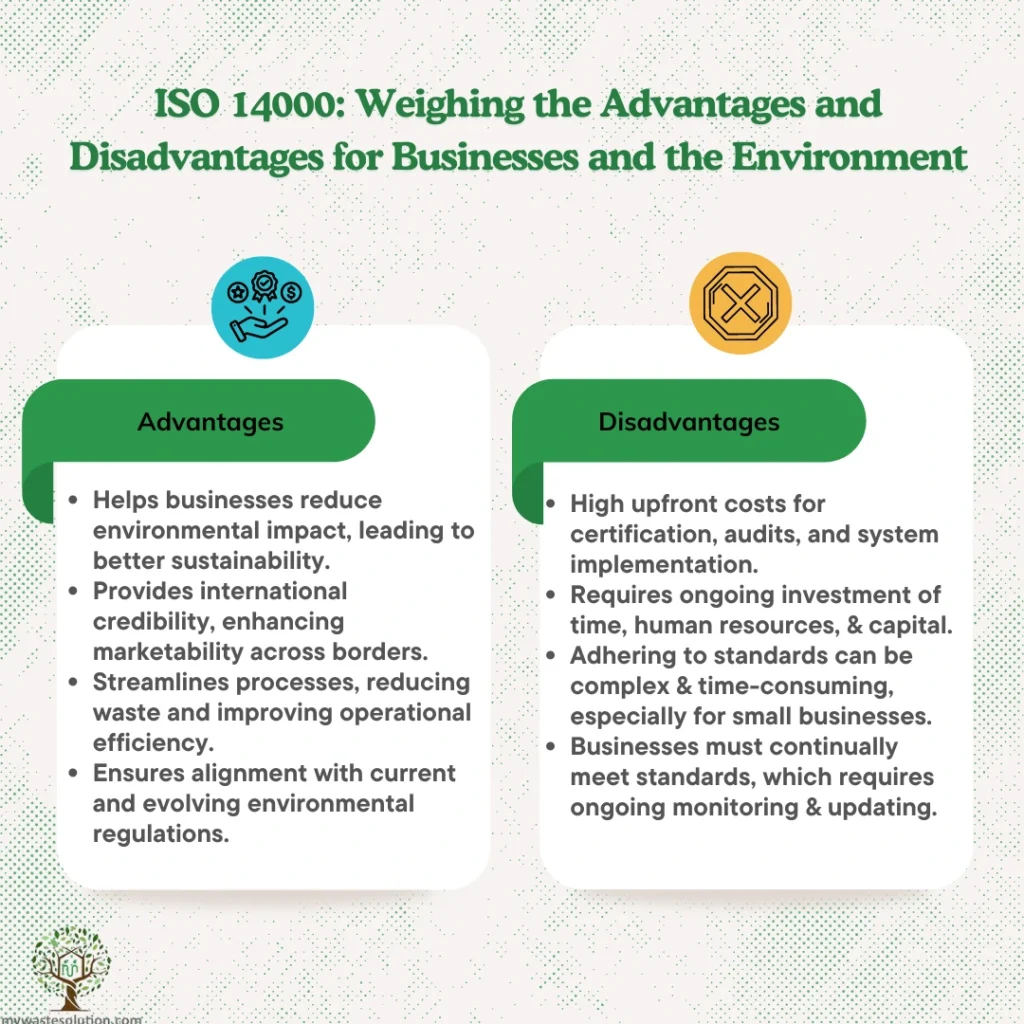
Implementing the ISO 14000 Elements can provide significant benefits for businesses focused on environmental sustainability. However, it’s essential to be aware of potential challenges. Below, we explore the key advantages and disadvantages of adopting these standards to help you make an informed decision.
7.1 Advantages of Implementing ISO 14000 Compliance:
- Improved management of both current and future environmental risks.
- Enhanced market access to new customers and business partners.
- Proof of compliance with legal and regulatory requirements.
- Cost savings through reduced consumption, waste, and efficient recycling practices.
- Helps reduce overall waste production.
- Assists in minimizing a company’s carbon footprint.
- Lowers operational expenses like energy costs, taxes, and insurance premiums.
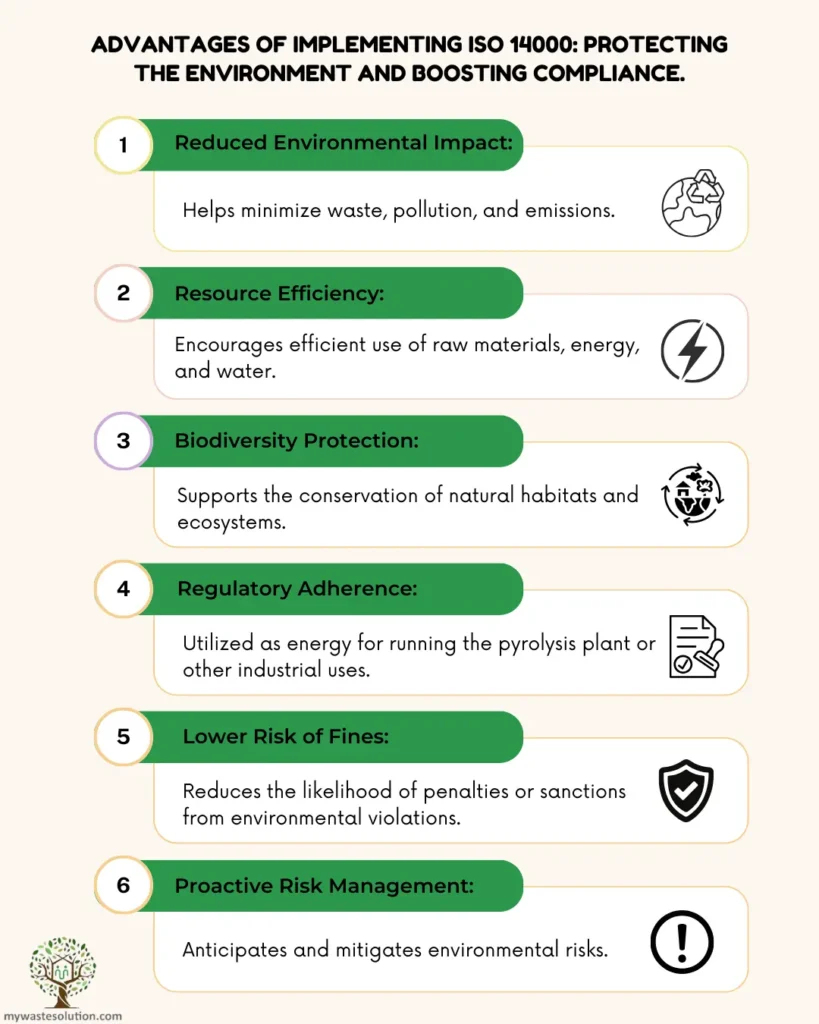
7.2 Disadvantages and Challenges of ISO 14000 Elements:
- Certification costs and ongoing maintenance fees.
- Requires time and resources to maintain compliance with the standards.
- Implementation poses a significant organizational change that must be carefully managed.
- High implementation costs if not executed properly.
- May involve extensive administrative work to meet standards.

8. Conclusion
Evaluating the ISO 14000 Elements is crucial for businesses aiming to understand its long-term impacts on environmental management. Today, organizations that envision the natural environment as both a vital supplier and a valued customer are the ones poised for a successful future.
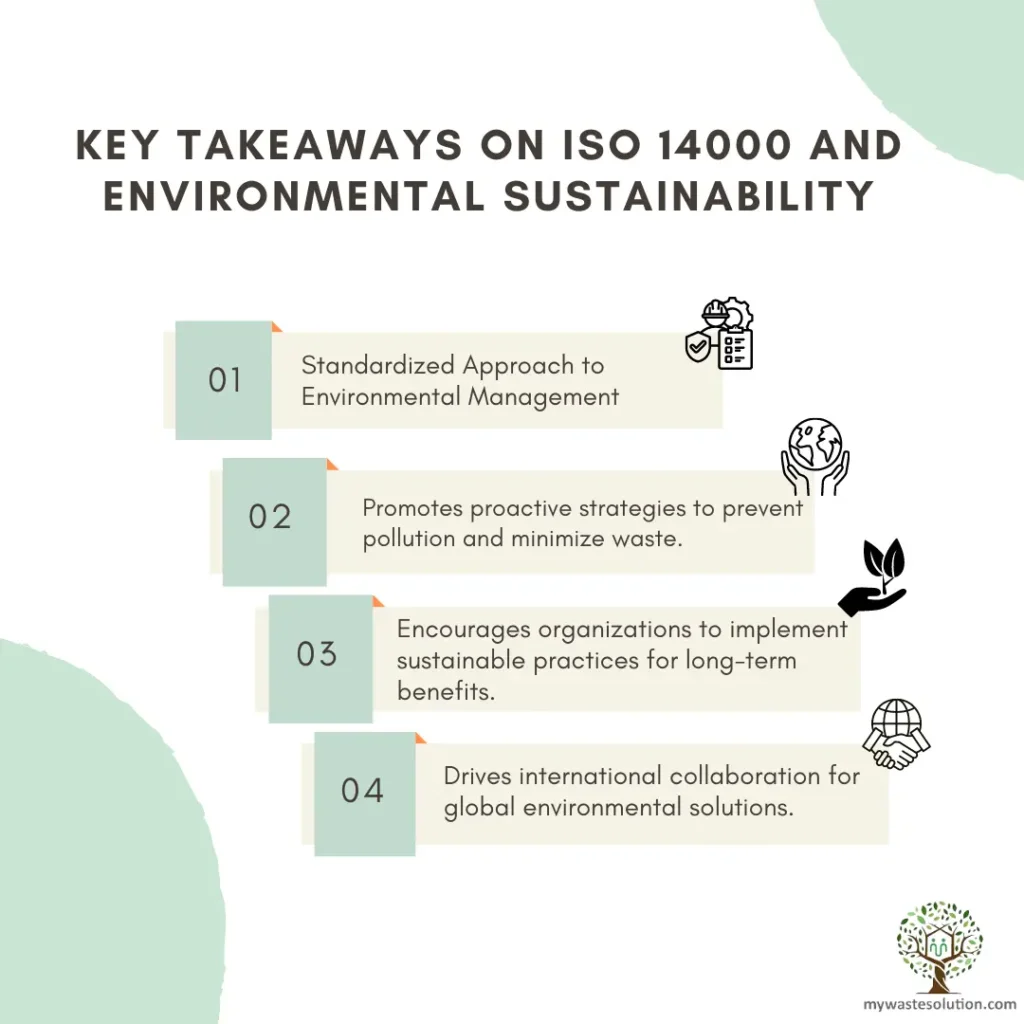
The International Corporation for Standardization framework enables Companies to efficiently and systematically meet Sustainable standards. So, why wait? Take the next step and get your organization ISO 14000 certified now!

